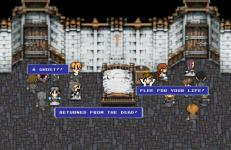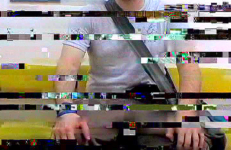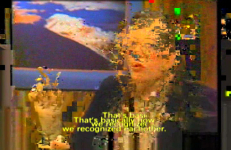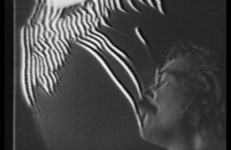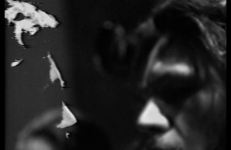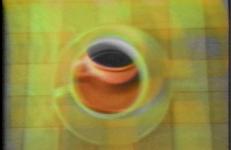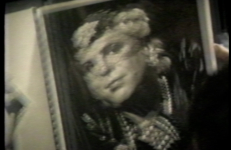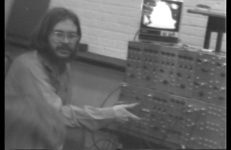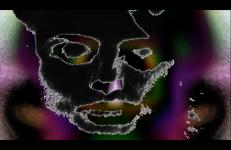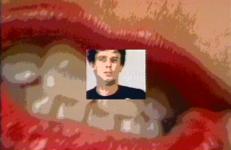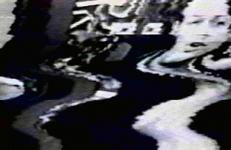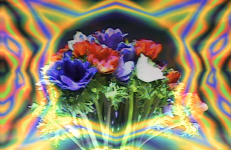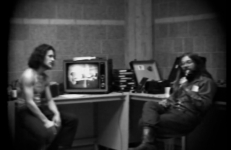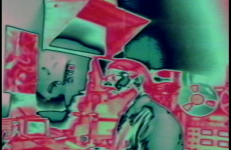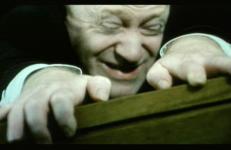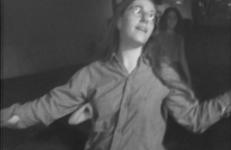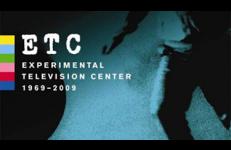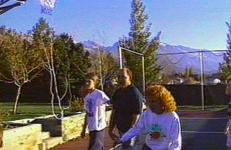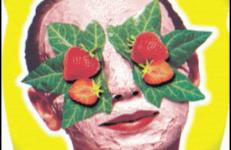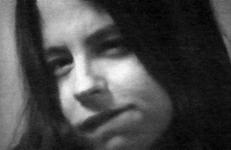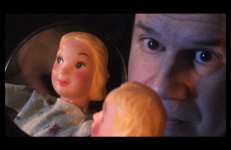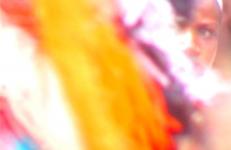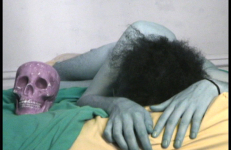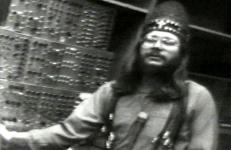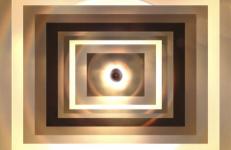In part a remake of Hollis Frampton’s Gloria! (1979), in part a repurposing of hacked, 16-bit video game technology, The Well of Representation asks us to reconsider our fear of the liminal. Following the convergent narratives of several voices, ranging from the linearly historical to the cybernetically personal, we come to understand the journey ahead: searching from interface to interface, knowing that whatever home we find will be a collaborative compromise. One where we might live beyond our representations and finally come to say what we mean.
Image Processing
Fashioned out of home movies recovered from failing hard drives, this glitch-art video makes comparisons between different forms of memory - suggesting that, while error and decay may keep us up at night, they might also be the way we put our ghosts to bed.
-- Evan Meaney
We have come to this place of meaning together, celebrating our un-remaindered completeness. Yet, in our wake endures a long procession of stowaways: misspoken sounds we unconsciously omit, the limitations of our alphabet, the ignored gaps of an imperfect analog, and most recently, these forgetful bits of the virtual. We celebrate the lineage of our information as we celebrate one another, not realizing that the loudest affirmations might come from these unacknowledged, unavoidable participants. With each generation, they say a little bit more, speaking a little bit louder.
The video opens with visual feedback and various sounds including snoring, whistling, and other generated audio. The video then slowly transitions into Phil Morton’s monologue and a solarized image. Phil is in front of video equipment racks at the Governors State University—a public university in University Park, Illinois. He starts by discussing events at the school, and then draws the viewers’ attention to the video waveform behind him as he sways. He says that “all things in the universe are so interconnected,” and ends up in laughter.
Featuring overlaying monologues, Phil Morton brings up a wide range of philosophical and mundane topics: self-exploration, evolution, personal values, frustration, exhaustion, spirituality, video making, etc. He discusses the capability of video as a tool for expansion of perception.
"A cup and saucer, pouring and drinking coffee, a duration ritual of contemplation and invigoration, doubled (tape copied), mixed, keyed + synthetic color, normal play and rewinding, sync events, the opening of a space to put the self in. 1/2 inch b+w Portapack, 2 reel to reel video tape decks, David Jones keyer and colorizer."
– Peer Bode
Teramana spends time with drag performer Dainty Adore O’Hara (Mitchell Allan Marco) in Dainty’s apartment in New York City. Dainty, her friend, and Teramana exchange friendly, humorous banter as they flip through Dainty’s collection of photographs and artworks, and Dainty shows off her dress collection, many of which she made herself. The production date for this title is unknown, but presumed to have been recorded after 1991.
In this hour-long video, Dan Sandin demonstrates and explains in detail on modules of the Sandin Image Processor. Beginning with a playful and amateurish set up segment, Dan introduces his new invention, which he hints will be duplicated by Phil Morton shortly.
This video uses a yoga performance by Barbara Breder to explore the masks of life and the dance of death.
An insert square of a man running is superimposed over a magnified mouth that speaks to him — first in nurturing encouragement, then with a no-win Mommie Dearest kind of criticism. Originally presented as an installation on six monitors, Deadline focuses on “the stress man feels in the urban environment,” using a range of digital video effects to stretch, compress, flip and fracture the image.
A specific period of late-night TV channel surfing is dissected and manipulated through fast forward and freeze frame. Cultural icons (Roseanne, Mary Tyler Moore, The Golden Girls) can occasionally be glimpsed amongst the detritus, while the echoing and ghostly soundtrack pays homage to the cultural isolation of solitary viewing.
This film is a recording of a live signal analog video/audio synthesizer performance with a voiced narration made in collaboration with an AI program. A speculative machine guided psychedelic broadcast of an astral floral projection. A fictional telepathic transmission that saturates the boundaries of perception with interlacing signals of interconnected consciousness.
— Les LeVeque
Phil Morton and Dan Sandin introduce video equipment and editing techniques to St. Olaf College students—a private liberal arts college in Northfield, Minnesota. They display constant playful interactions, from deliberately making audio feedback to mimicking the feedback sounds with voice. The workshop is very laid-back and carefree which is typical of the '70s counterculture and DIY Video communities.
Dan Sandin demos the Digital Image Colorizer, a digital module that was part of the analog Image Processor.
Imagine that the camera is possessed with a psychosis similar to human schizophrenia; suppose that this disease subtly changes every single frame of film while leaving the narrative superficially intact. Then imagine that these symptoms came on as a result of the trauma of recording bizarre or horrific events, for instance those of the 1941 horror film Dr Jekyll and Mr Hyde...
Adapted from the novel by Robert Louis Stevenson.
This title is also available on Paul Bush Pixilated.
Electric Yogurt documents different modes of childlike play, beginning with footage of a group of people dancing together with arms outstretched against a background of growling, cooing, and coughing. As the dancing continues, the participants get increasingly tangled up in one another and repeatedly chant the word “culture,” eventually transitioning into a trust fall. The enactment of these activities is simultaneously playful and somewhat disturbing, particularly as they parallel symbolic enactments of American nationalism.
ETC: Experimental Television Center 1969-2009 is a five-DVD box set presenting the electronic media work of over one hundred artists who participated in the Center’s Residency Program during a 40-year period. The collection offers a look at the evolution of the unique artist-designed sound and image tools that are the hallmark of the Center’s studio, and provides a view into the constantly changing artistic processes and practices that have shaped the work over the years.
Family Court introduces us to the world of good, clean, family fun and leisure.
This title is also available on Animal Charm Videoworks: Volume 2, Hot Mirror Mix.
Fantasy Suite was the last standard definition video I made from VHS tapes. Like WHS VHS #1, I made it to premiere at Roots & Culture’s Zummer Tapez, and speed manipulation figured heavily into its construction (the Bachelor material was not interesting or even tolerable at normal speed, but slowed down slightly, it became fascinating to me). Shana Moulton’s work was a strong influence on this video (I programmed my piece to play after hers in the Zummer mixtape), hence the animated facial masks and SkyMall imagery.
Feathers: An Introduction is a self-portrait centered on the story of Latham's grandmother’s comforter which, old and worn, scatters feathers everywhere. Displaying an arresting stage presence, Latham addresses the viewer as a potential friend or lover, speaking in a soft-spoken near-whisper, and gingerly touching and kissing the camera lens and monitor. Then, almost mocking the video’s intimacy, Latham gives us close-ups of herself chewing a sandwich and shaving her armpits, heightening the sense that she has been playing cat and mouse with the viewer all along.
The temperature in your eyes will rise when you contract ‘FEVER DREAMS’ and experience the haunted mayhem contained therein.
This title comprises The Stone Boy (2011), Nonsensical (2014), and Coffee, Tea, and Wizardry (2015) which were compiled into this form by Mike Kuchar in 2022.
A short Flicker Film adulterated by some extra images shot in Malawi, Africa. FF was in answer to an assignment given by artists Melissa Dubbin and Aaron Davidson who created the soundtrack to which I was asked to make a “Future Film”.
-- Deborah Stratman
See a boy turn into a tiger. See the lad vomit colors of the rainbow. Watch him toss marbles onto wet bathroom tiles while holding up a green skull. See him squirm on warm bedsheets, wearing only soiled socks on his feet…… This kid has a mouthful of flowery words to spit out to you !
This title comprises Witchery (2008), The Tiger (2009), Swan Song (2009), Medusa's Gaze (2010) and Opal Essence (2010) which were compiled into this form by Mike Kuchar in 2022.
In 1973, Dan Sandin designed and built a comprehensive video instrument for artists, the Image Processor (IP), a modular, patch programmable, analog computer optimized for the manipulation of gray level information of multiple video inputs. Sandin decided that the best distribution strategy for his instrument "was to give away the plans for the IP and encourage artists to build their own copies.
Decidedly low-tech, this optical abstraction begins with a shot of an aluminum reflector inside a lamp; a lightbulb in the shot’s center flicks on and off. As the video plays on, nearly identical shots are superimposed, but at a steadily decreasing scale, resulting in an array of nested rectangles. The rhythmic blinking of intense light- accompanied by audible clicks from the plastic light switch- presents the viewer with a swift progression of blinding geometries, (with) dizzying effects.
-- Michelle Grabner, Artforum, May 2010




